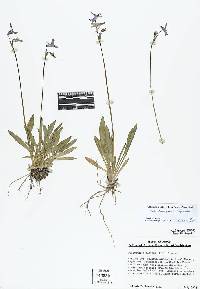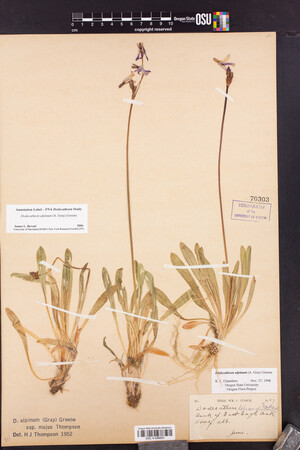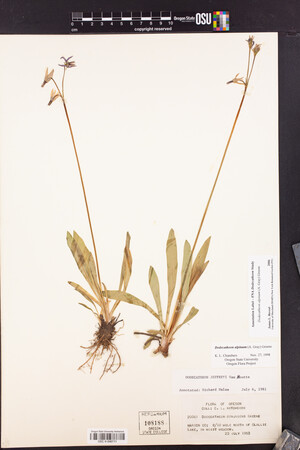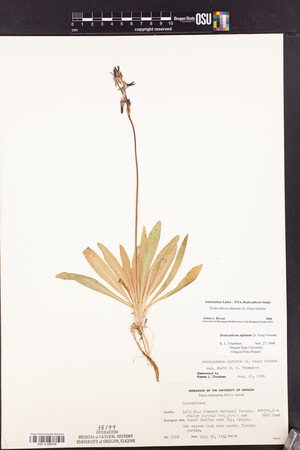Dodecatheon alpinum
|
|
|
|
Family: Primulaceae
alpine shootingstar, more...shooting star
|
Plants (8-)10-35(-45) cm; scape glabrous or nearly so. Caudices not obvious at anthesis or short and compact; root whitish; bulblets absent. Leaves 2-20(-27) × (0.3-)0.5-2(-3.5) cm; petiole winged; blade linear to linear-oblanceolate, base decurrent onto stem, gradually tapering to petiole, margins entire or nearly so, surfaces glabrous. Inflorescences 1-10-flowered; bracts lanceolate, 3-10(-12) mm, usually glabrous, sometimes sparsely glandular-puberulent. Pedicels (0.5-)1-5 cm, usually glabrous, rarely sparsely glandular-pubescent. Flowers: calyx greenish and finely purple-flecked, 5-9.5(-10) mm, usually glabrous, rarely sparsely glandular-puberulent, tube 1-3(-4) mm, lobes 4, (2-)4-7(-8) mm; corolla tube yellowish with purplish red, thin, wavy ring, lobes 4, usually magenta to lavender, rarely pink or white, (6-)8-20 mm; filaments distinct, black, 0.2-0.5(-1) mm; anthers 4.5-8.5 mm, (apex truncate to obtuse); pollen sacs purple and often mottled, connective dark purple, transversely rugose; stigma enlarged, diam. usually 2+ times style. Capsules tan to light brown, often purplish toward apex, valvate, narrowly ovoid, 5-11(-12) × 3-7 mm, glabrous; walls thin, pliable. Seeds with membrane along edges. 2n = 44. Flowering late spring-summer. Moist to boggy meadows and stream banks, mainly in montane conifer woodlands; 1900-3500 m; Ariz., Calif., Nev., Oreg., Utah, Wash. Dodecatheon alpinum is found in widely scattered locations in the San Jacinto Mountains, Transverse Ranges, Sierra Nevada, northern coastal ranges, and the Siskiyou Mountains of California, southwestern Oregon, and west-central Nevada, and in the Cascade Ranges to just north of the Columbia River in Skamania and Yakima counties of Washington. It may be seen on scattered basin ranges in the Intermountain West of Nevada (e.g., East Humboldt, Jarbidge, Ruby, Snake) and western Utah (Deep Creek Mountains), and in some desert ranges of southern Oregon as far east as the Steens Mountains in Harney County; it is disjunct to the Blue and Wallowa mountains of northeastern Oregon. There are other disjunct populations in the northern Wasatch and Uinta mountains of northern and northeastern Utah, and even more widely scattered populations in the southern Wasatch and Tushar mountains. The species has also been found at Warm Springs in Millard County. Isolated populations occur on the Pine Valley Mountains, Utah, and around the Grand Canyon and Mogollon Rim areas of Arizona as far south as Greenlee County. Narrow-leaved plants that are sparsely glandular-pubescent are sometimes found at higher elevations in the Sierra Nevada, making a distinction between Dodecatheon alpinum and D. jeffreyi occasionally arbitrary. A specimen from Deschutes County, Oregon (C. L. Hitchcock and J. S. Martin 4919, UTC, WTU) has leaf blades to 3.5 cm wide.
Plant: Perennial herb; 10-45 cm tall, with upright stems Leaves: 2-15 cm long; blade tapering gradually to the petiole, linear to oblanceolate, the margins entire INFLORESCENCE: a scapose umbel Flowers: pink to purple; calyx 6-9 mm long, deeply lobed, the lobes 4; corolla (reflexed portion) 9-19 mm long, deeply lobed, the lobes 4; stamens 4, the filaments purple, less than 1 mm long or nearly absent; stigma enlarged, twice the diameter of the style Fruit: FRUITS generally valvate Misc: Moist mt. meadows; 2000-3050 m (6500-10000 ft); May-Sep REFERENCES: Cholewa Anita F. 1992. Primulaceae. Ariz.-Nev. Acad. Sci. 26(1)2 General: Perennial, 9-40 cm tall; scapes erect, solitary or few; herbage glabrous; roots fibrous, fleshy. Leaves: Basal, forming a rosette, linear to narrowly oblanceolate, 4.5-15 cm long (including petiole), glabrous, margins entire to somewhat wavy, base gradually tapering to petiole, apex obtuse to rounded; petiole winged. Flowers: Inflorescence an umbel, 3-25 flowered; involucral bracts narrowly lanceolate to linear; pedicels slender, 0.4-7 cm long, the central ones usually the longest; calyx top- shaped, 3.3-5 mm long, lobes 5, spreading, triangular, 1- 1.6 (2) mm long, shorter than the tube, greenish to red- tinged; corolla minute, the tube as long as the lobes, these 1.2-1.5 mm long, white; flowers April-September. Fruits: Capsule, oblong-ovoid, 6-11 mm long, 5-valved at apex; seeds numerous, minute. Ecology: Mountain meadows, alpine to subalpine habitats, mixed conifer forests; 2000-3000 m (6500-10000 ft); Apache, Coconino, Greenlee, and Navajo counties; western to southwestern U.S. Notes: Dodecatheon dentatum (Wasatch shooting star) [=D. ellisiae] is distinguished by ovate leaves, the base rounded to cordate, abruptly contracting to the petiole; it has 5 corolla and calyx lobes, the corolla lobes white. It occurs along streambanks, in moist shaded habitats, and on rock outcrops in eastern Arizona. Dodecatheon pulchellum (dark-throat shooting star) also has 5-parted flowers, a somewhat shorter calyx (3.5-7 mm long), and stamens with connate filaments, exposed beyond the corolla for 1.8-3.6 mm. Its leaves taper to the petioles and the blades are mostly spatulate to oblanceolate or elliptic. Alpine shooting star is a host plant for the arctic blue butterfly. Editor: Springer et al. 2008 |









































































